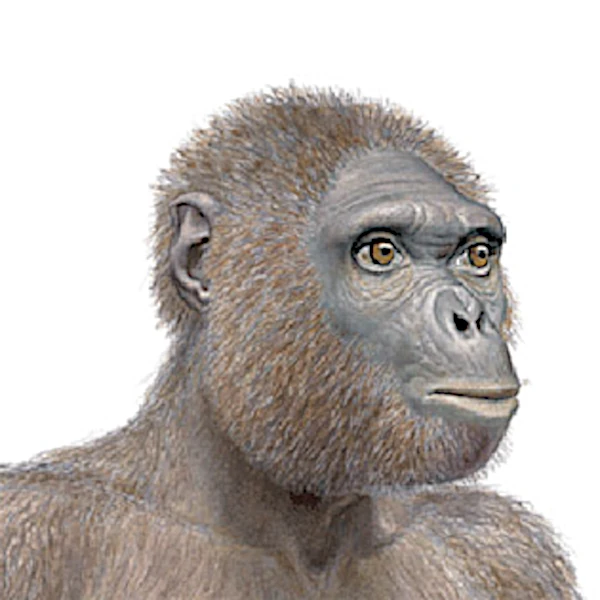
Ardipithecus ramidus, discovered in the Afar region of Ethiopia, represents one of the most significant paleoanthropological discoveries of the 20th century. The first fossil fragments were unearthed in 1992 by a team led by Tim White, but it was not until 1994 that the partial skeleton nicknamed "Ardi" was identified. Dated to 4.4 million years ago, this hominid lived in a forested environment, not in the savanna as traditionally thought for early bipedal hominids.
Ardipithecus exhibits a fascinating mix of primitive and derived traits. The fossils show a creature about 1.20 meters tall and weighing 50 kg. Its brain, about \(300 \text{ to } 350 \text{ cm}^3\) in size, was comparable to that of modern chimpanzees. Its dentition shows reduced canines, unlike those of great apes, suggesting less aggressive social behaviors. The broad pelvis and the position of the foramen magnum indicate adaptation to bipedalism, although its feet retained an opposable hallux (prehensile big toe) for climbing trees.
Contrary to previous theories that placed the emergence of bipedalism in an open savanna environment, Ardipithecus lived in a forested setting. This discovery led to a reconsideration of the evolutionary pressures that favored bipedal locomotion. Bipedalism may have emerged to facilitate movement between scattered trees or to carry food in a mixed environment. Ardipithecus thus represented a remarkable adaptation to a lifestyle combining arboreal and terrestrial movement.
Ardipithecus ramidus, 4.4 million years old, is not just an ancient hominid: it also belongs to the hominin subfamily, meaning it is closer to humans than to orangutans.
This classification means that Ardipithecus shares a common ancestor with chimpanzees and humans but is on the branch that leads directly to our lineage. Its unique combination of traits, blending occasional bipedalism and arboreal ability, illustrates the gradual evolution of characteristics typical of hominins, particularly two-legged locomotion.
As a hominin, Ardipithecus provides crucial clues about the early stages of divergence between our lineage and that of chimpanzees, shedding light on the transition between ancient great apes and later australopithecines. Its place in the Hominini tribe makes it a key pivot for understanding human origins.
N.B.:
A hominid includes all living and fossil great apes, including humans, while a hominin refers to the subfamily that excludes orangutans and includes gorillas, chimpanzees, and humans. Thus, all hominins are hominids, but not all hominids are hominins.
Ardipithecus ramidus predates Australopithecus afarensis (which includes the famous "Lucy") by about a million years. It is close to the divergence between the human lineage and that of chimpanzees, estimated between \(5 \text{ and } 7 \text{ million years ago}\). This chronological position makes it a crucial witness to the adaptations that led to later hominids. Recent discoveries suggest that Ardipithecus was probably not a direct ancestor of Homo sapiens, but rather a cousin branch that explored an alternative evolutionary path.
| Species | Age (millions of years) | Cranial Capacity | Average Height | Average Weight | Mode of Locomotion | Diet | Environment |
|---|---|---|---|---|---|---|---|
| Ardipithecus ramidus | 4.4 | 300–350 cm³ | ≈ 1.20 m | ≈ 50 kg | Occasional bipedalism + arboreal life | Omnivore (fruits, seeds, roots, small invertebrates) | Clear forests and wooded areas |
| Australopithecus anamensis | 4.2–3.9 | ≈ 365–370 cm³ | ≈ 1.20–1.40 m | ≈ 45–55 kg | More pronounced bipedalism than Ardipithecus, but still capable of climbing | Mainly frugivorous, with tubers and seeds | Open wooded environments and savanna areas |
| Australopithecus afarensis (Lucy) | 3.2 | 400–450 cm³ | ≈ 1.05–1.50 m | ≈ 30–45 kg | Established bipedalism, residual climbing | Mostly frugivorous, supplemented by tubers | Wooded savannas of East Africa |
| Homo habilis | 2.4–1.6 | 600–700 cm³ | ≈ 1.25–1.40 m | ≈ 35–50 kg | Complete bipedalism, stone tools | Omnivore with increased meat consumption | Savannas and open landscapes of East Africa |
| Homo erectus | 1.9–0.1 | 850–1100 cm³ | ≈ 1.50–1.80 m | ≈ 50–70 kg | Modern bipedalism | Opportunistic omnivore, controlled use of fire | Africa, then Eurasia (varied climates) |
| Homo sapiens | 0.3 – present | 1300–1600 cm³ | ≈ 1.60–1.85 m | ≈ 55–90 kg | Modern bipedalism | Omnivore, agriculture, livestock, symbolic culture | All geographic areas, high adaptability |
Sources: White T. et al. (2009), Science; Smithsonian Human Origins; Tattersall I. (2012), Masters of the Planet, Palgrave Macmillan; Antón S.C. (2003), Natural History of Homo erectus.